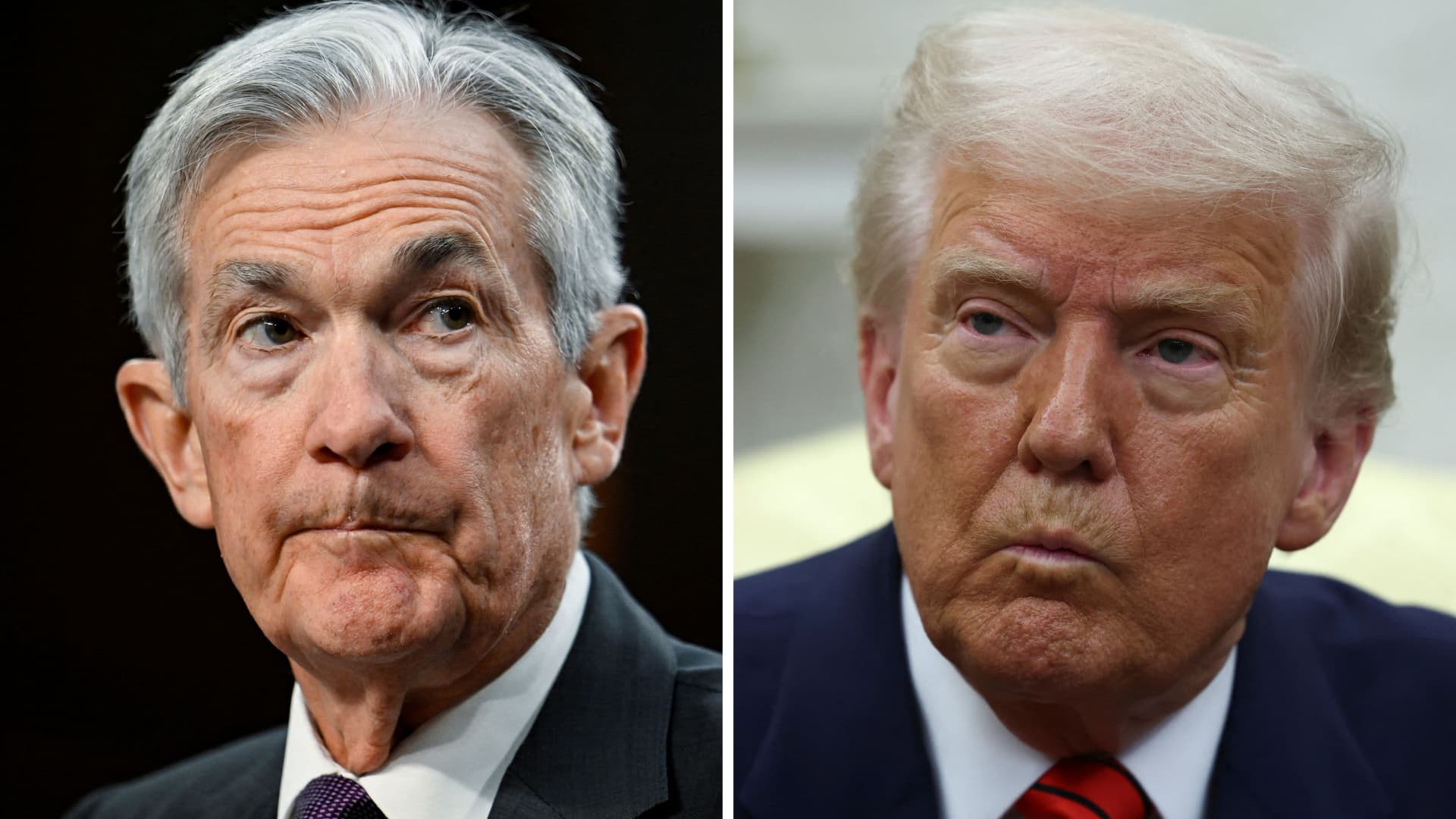Protestors in New York City demonstrate against the push by President Donald Trump and Elon Musk, who leads the so-called Department of Government Efficiency, to gut federal services and impose mass layoffs, Feb. 19, 2025.
Michael Nigro/Pacific Press/LightRocket via Getty Images
The Trump administration’s purge of federal workers may ultimately amount to the biggest job cut in U.S. history, which is likely to have ramifications for the economy, especially at the local level, according to economists.
The White House, with the help of Elon Musk’s so-called Department of Government Efficiency, has fired or offered buyouts to workers across the federal government, the nation’s largest employer.
While the precise scale of the job cuts is as yet unclear, evidence suggests it’s at least in the tens of thousands so far, economists said.
The Trump administration directed federal agencies to dismiss “probationary” employees. Probationary workers are more-recent hires who have been with the federal government for only a year or two and who do not yet have full civil service protections.
There were about 220,000 federal employees with less than a year of tenure as of May 2024, according to the most recent data from the U.S. Office of Personnel Management.
Additionally, more than 75,000 federal workers have accepted a buyout offer, according to a Trump administration official. They agreed to resign but get paid through September.
The total of these two groups — nearly 300,000 workers — would make these actions amount to the “largest job cut in American history (by a mile),” Callie Cox, chief market strategist at Ritholtz Wealth Management, wrote Tuesday.
That sum doesn’t include others who may be on the chopping block, such as contractors who work at the U.S. Agency for International Development. Career civil servants who got promotions in the past year are also at risk of losing their jobs, since they’re technically on probation in their new role, Jesse Rothstein, a public policy and economics professor at University of California, Berkeley, said in a podcast Thursday.
Job cuts have come from across the government, at agencies including the Internal Revenue Service, National Park Service, Consumer Financial Protection Bureau, and the departments of Agriculture, Education, Energy, Health and Human Services, Homeland Security, and Veterans Affairs, according to the Associated Press.
“We may soon find out the hard way that people drive the U.S. economy,” Cox wrote.
Assessing the scale of federal job cuts
Arlene Rusch, former Internal Revenue Service worker, shows an email notifying her that she has been laid off, as she leaves her office in downtown Denver, Colorado, Feb. 20, 2025. The IRS began laying off roughly 6,000 employees in the middle of tax season as the Trump administration slashes the federal workforce.
Hyoung Chang | Denver Post | Getty Images
The ultimate number of cuts isn’t likely to be as high as 300,000, economists said.
For example, there may be some crossover: Probationary workers who would have been fired may have accepted a buyout. Also, in some cases, the Trump administration tried hiring back workers who’d been terminated.
Public disclosures show more than 26,000 federal workers have already been fired, excluding buyouts, according to a research note Wednesday from investment bank Piper Sandler.
That’s about the same number of workers who lost their jobs when Lehman Brothers collapsed during the 2008 financial crisis, for example.
More from Personal Finance:
Sen. Elizabeth Warren: DOGE’s FDIC firings put banking system at risk
Top-rated charities in jeopardy amid White House, DOGE cuts to foreign aid
A potential winner from Trump tariffs: Tourists traveling abroad
But Thomas Ryan, a North America economist at Capital Economics, estimates that between 100,000 and 200,000 federal staffers have probably already been let go.
That would handily beat IBM’s 1993 purge of 60,000 workers, thought to be the largest corporate layoff in U.S. history. Among other notable corporate cuts, Citigroup and Sears, Roebuck & Co. each slashed about 50,000 jobs, in 2008 and 1993, respectively.
“Certainly if all 200,000-plus probationary workers are fired [without replacement] that would be historic,” Susan Houseman, senior economist at the nonpartisan W.E. Upjohn Institute for Employment Research, wrote in an e-mail.
Even among prior federal layoffs, the scale of potential cuts appears unprecedented, experts said.
The U.S. Army, for example, eliminated 50,000 jobs in September 2011 as former President Barack Obama withdrew troops from Afghanistan and Iraq, according to outplacement firm Challenger, Gray & Christmas. The U.S. Air Force announced plans in 2005 to reduce head count by 40,000, the firm said.
We may soon find out the hard way that people drive the U.S. economy.
Callie Cox
chief market strategist at Ritholtz Wealth Management
The Bureau of Labor Statistics tracked data on federal mass layoffs from 1995 to 2003. During that period, mass layoffs affected anywhere from roughly 9,000 federal workers per year to 23,000 a year, the data show.
If the current federal job cuts “are not historic yet, it feels like we’re headed in that direction pretty quickly,” said Mark Zandi, chief economist at Moody’s.
The White House didn’t comment on the specific scale of cuts.
“President Trump and his administration are delivering on the American people’s mandate to eliminate wasteful spending and make federal agencies more efficient, which includes removing probationary employees who are not mission critical,” Anna Kelly, a White House spokesperson, said in a written statement. “This is part of President Trump’s sweeping effort to save taxpayer dollars, cut wasteful spending, and restore our broken economy.”
Potential economic impact
Job loss can be painful for household finances.
Affected workers who can’t quickly find new jobs may be forced to make ends meet without regular income. Unemployment benefits may offer a temporary stopgap to eligible workers, but they replace only about a third of prior wages, on average, according to Labor Department data.
The majority of workers who suffer job loss are affected long term, as they have trouble finding new full-time jobs and subsequently earn less money, according to a 2016 research paper by Henry Farber, professor emeritus of economics at Princeton University, who studied data from 1981 to 2015.
“There are economic impacts to [laid-off workers], their families, to the businesses they would have bought goods and services from,” said Erica Groshen, a senior economics advisor at Cornell University and former commissioner of the U.S. Bureau of Labor Statistics.
“The economic consequences of layoffs are like a domino effect that spread across local economies to businesses that seem to have no connection whatsoever to the federal government,” said Ernie Tedeschi, director of economics at the Yale University Budget Lab.
Laid-off workers may spend less at businesses such as local coffee shops, restaurants and day care facilities, he said.
There’s a psychological factor to mass layoffs, too, economists said. Other federal workers, fearful for their jobs, may pull back on spending and delay big-ticket purchases. Businesses with ties to the federal government or the federal workforce may stop hiring and investing due to uncertainty.
Washington, D.C., for example, is expected to suffer a “meaningful” increase in unemployment that would push the capital into a “mild recession,” Adam Kamins and Justin Begley, economists at Moody’s, wrote in a note Tuesday.
Close to 100,000 federal government positions will be eliminated or moved from Washington in the next couple of years, Kamins and Begley estimate. A “flood” of job applicants will limit the private sector’s ability to absorb them into the labor pool, they said.
The economies of Maryland and Virginia won’t suffer to the same degree but will be “materially” hurt due to their exposure to government employment, Kamins and Begley wrote.
Layoffs aren’t likely to show up in federal data for another month, and not until September for those who take the severance deal, according to Piper Sandler. Unemployment claims in Washington, D.C., for the week ended Feb. 8 were up 36% from the prior week.
‘Not recessionary’ on its own
Economists don’t expect the job cuts will have a huge impact on the overall U.S. economy, however.
If about 200,000 probationary workers were to lose their jobs, it would shave roughly one-tenth of a percentage point from annual U.S. gross domestic product, said Tedeschi, who served as chief economist at the White House Council of Economic Advisers during the Biden administration.
“This, on its own, is not recessionary,” he said.
Elon Musk, second from the left, walks along the colonnade at the White House on Feb. 19, 2025.
Win Mcnamee | Getty Images News | Getty Images
Ryan, of Capital Economics, said the scope of federal layoffs is relatively small when considered in the context of the U.S. labor market, which added roughly 1.5 million jobs in 2024. He said he expects most displaced federal workers to be rehired quickly since the economy is near full employment, “making any pain short-lived.”
Capital Economics hasn’t downgraded its economic growth forecasts due to the federal layoffs, Ryan said. That assessment includes potential ripple effects felt indirectly through the economy.
“Even adding the knock-on effects, it’s not going to plunge the U.S. into a recession,” Tedeschi said. “Let’s be realistic here.”
But mass layoffs add to the pressure already being placed on the economy by other Trump administration policies, such as tariffs and mass deportations, economists said.
“This was a healthy economy coming into 2025,” Tedeschi said. “And suddenly we have a number of serious potential headwinds that are stacking up. And this is one of them.”


 Economics7 days ago
Economics7 days ago
 Economics7 days ago
Economics7 days ago
 Economics5 days ago
Economics5 days ago
 Finance7 days ago
Finance7 days ago
 Economics7 days ago
Economics7 days ago
 Blog Post5 days ago
Blog Post5 days ago
 Personal Finance5 days ago
Personal Finance5 days ago
 Finance5 days ago
Finance5 days ago













